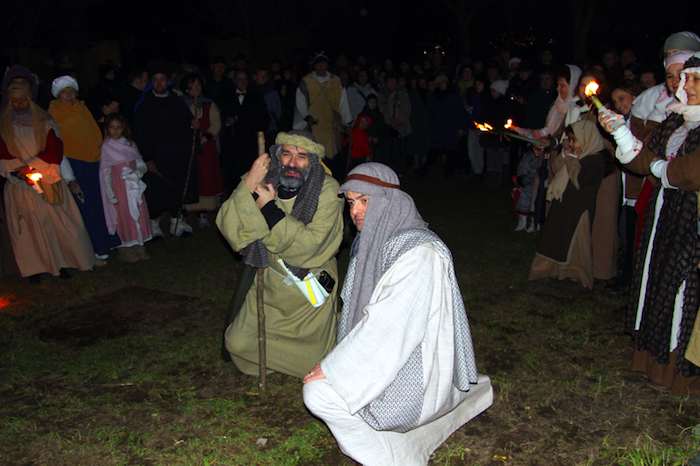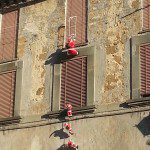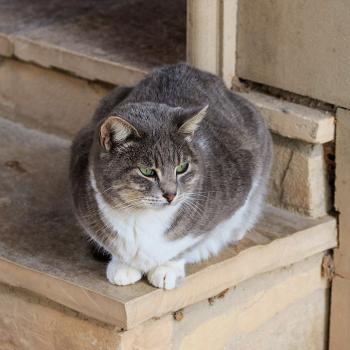
After twelve days of feasting the Christmas Witch sneaks in to slip coal or candy into stockings. What? Not in your country? Perhaps you should be living in a different Nativity.
The Nativity sets most us probably just packed away originate with St. Francis of Assisi, credited with making them part of Christian seasonal observance. Preaching in 1223 in the town of Greccio, St. Francis called townspeople to worship Jesus as He lay humbly in a manger. Now, Italians preparing for Christmas set up manger scenes everywhere: in churches, civic spaces, shop windows, sometimes multiple versions right next to each other. Some sets have a multitude of figures, some light up, and some are mechanized so that angels beat their wings and cooking pots boil and fishermen lift lines in and out of real water.
Our family was in Italy for December this year, following a term at the Gordon College program in Orvieto, and we considered two traditions for the holidays: the Living Nativity and the Christmas Witch. The first is a combination of manger scene and Christmas pageant. A December 25th version in Orvieto presented the Holy Family in a cliffside cave, accompanied by angels and shepherds and beasts of burden. Along with them, though, came the trappings of a whole olden-day town. (Though it was not exactly clear which time and place were being evoked: Bible times? The Umbria of St. Francis? Nineteenth-century Italy?) Costumed artisans were gathered there at dusk, blacksmiths and leatherworkers and woodworkers and laundresses in clusters around the field, most around open fires in high breeze. A horse was tethered to a tree. Rough-clothed children played. A troop of costumed shepherds entered, the Christmas story from the gospel of Luke was read, and attention turned to the lighted cave. Before and after the glad tidings people attended to their scripted business. It looked as though half the town was in costume and the other half had come to see, mingling and trading good wishes. 
All those workshops appeared to be crucial to the Living Nativity. The Nativity scene I get. The scale of business and bustle around it I understand less, though I think I like it. Inviting the whole town to a presentation of the Savior’s birth is wonderful. I’m not sure what the presence of a blacksmith, with real fire and real horse, adds to the announcement of the Incarnation. Still, the act of pretending all that other business is going on when the Savior arrives is frank concession that in Bethlehem, as now, the big event takes place when many are busy with their own concerns. Some breed of accuracy, if not the narrowly historical, is advanced by re-enacting wordly business in order to be interrupted by the heavenly hosts.
The Living Nativity lasts only that night—the static manger scenes remaining for the next twelve days or so—but it is called forth again for Epiphany. The Wise Men arrive and with them (or the night before) comes the Christmas Witch, La Befana. She is the one from whom children here anticipate presents, lumps of coal or gifts in stockings depending on their behavior. (She gets more respect than Italians’ Americanized take on Santa Claus, Babbo Natale, unconvincing in his lankiness and tendency to appear in multiples.) 
A couple of explanations account for this witch, as a pagan goddess or a grief-stricken mother. A better story is that she was a woman whom the Magi met while following the star. She was a good housekeeper so they lodged with her. Ready to continue, the three Wise Men invited her to come along with them but she demurred because she was not done with her housework. Later she changed her mind and tried to follow, ever searching for the child, leaving things for other children on her way.
After a little wincing at a woman busy with broom instead of pondering the stars, I find that story appealing. It is painful, endearing, that what she perceived as right response to these Wise guests, these tidings, was to do more dishes. Still, the point was not altogether lost on her. In some ways the story of the Christmas Witch is a fine bookend to the Living Nativity. When we remember how prone we are to be overengaged in worldly business, we are prompted to tune our ears for the next time the herald angels sing.












